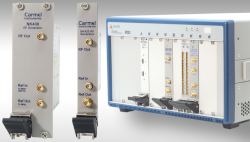
Covering a 50 MHz to 32 GHz frequency range, the NK420 and NK430 synthesizers bring the performance of expensive benchtop instruments to the PXIe format. The phase noise for the NK430 with a 10 GHz carrier is −124 dBc/Hz at 10 kHz offset (see Figure 1), and the noise floor is −149 dBc/Hz. The synthesizers achieve this extremely low phase noise at any frequency, even with a frequency resolution of 0.001 Hz and a maximum switching time of 50 μs for a full-range step.
The NK430 occupies only two slots in a PXIe chassis, while the NK420 is a single-slot instrument. The compact size and low cost of these YIG and VCO-based synthesizers enable practical configurations of eight or 16 signal sources in a single PXIe chassis, supporting applications from lab to production test. Applications include up- and down-converting to extend the frequency range of other instruments, low noise local oscillators for receivers, MIMO and phased arrays and clocks for A/D and D/A converters. Produc- tion testing of 5G devices and systems is an important market segment that these PXIe modules address.

Figure 1 NK430 phase noise.
Software for Windows and Linux is included with the products and consists of a ready- to-run virtual front panel graphical interface (see Figure 2) and driver for users who want to write control software in LabVIEW, C++, C#, Basic or Python. Sample programs are provided to serve as starting points. The same driver runs all products from Carmel Instruments, including frequency counters, time interval analyzers and clock generators.
The high performance, two-slot NK430 product line (see Table 1) consists of models covering two frequency ranges: 50 MHz to 10.5 GHz and 50 MHz to 21 GHz, with a full-band switching speed of 50 μs max. The output level is +15 dBm ±2 dB over the full frequency range and spurs are typically −60 dBc. The lower cost, single-slot NK420 line consists of six models (see Table 2). The step size of the NK420 is 1 kHz and the full-band switching speed is 3 ms maximum. All models include built-in frequency stepping and sweeping and a “list mode.”
All models accept an external frequency reference. For the NK420, the reference frequency can range from 10 to 200 MHz, while the external reference must be 10 MHz for the NK430. The NK420 has an option for an ultra-high performance internal 10 MHz frequency reference with phase noise of −140 dBc/Hz at 10 Hz offset, temperature stability of 5 ppb (0.005 ppm) over 0°C to 65°C and Allen Deviation of 5 × 10−12 with 1 s tau (i.e., short term stability). This optional NIST-traceable internal reference greatly improves the close-in phase noise of the synthesizer and its absolute frequency accuracy. It is available on a front panel SMA and can drive the reference clock on the PXI backplane, so all instruments in the chassis can use the same reference without connecting external cables.

Figure 2 Front panel graphical user interface.
With these products, Carmel Instruments set out to address the growing demand for higher volume testing created by the emerging markets for RF and microwave devices and systems. These markets require lower cost and smaller size as the applications become mainstream. High volume testing of semiconductor devices requires parallel testing of 16 or more devices to achieve cost-of-test targets. The fast tuning speed enables much higher throughput in applications with frequency sweeps.
Carmel Instruments has a 14-year record specializing in time and frequency measurement instruments for high speed production testing and scientific applications. The instruments are widely used in 24/7, high volume semiconductor test environments and high-reliability aerospace and atomic clock monitoring applications, such as at NIST, JPL and the U.S. Naval Observatory.


Carmel Instruments LLC
Campbell, Calif.
www.carmelinst.com
